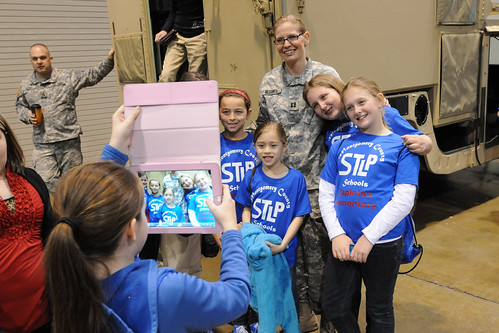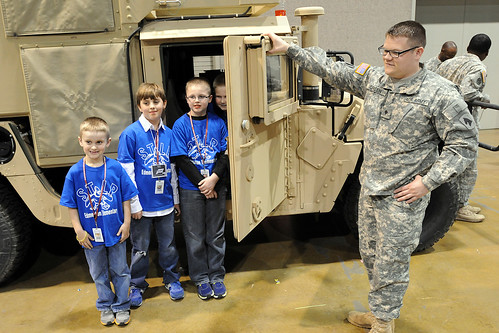Story and photos by Staff Sgt. Scott Raymond, Kentucky National Guard Public Affairs Office
[caption id="" align="alignright" width="350"]

Staff Sgt. Luis Berdecia of the 138th Fires Brigade holds the door of a Humvee as children climb inside for a look during the 2013 Student Technology Leadership Program in Lexington, Ky., March 28, 2013. Students had the opportunity to see the inside of military vehicles, try on helmets and talk with the Soldiers about their technical jobs in the military. (Kentucky National Guard photo by Staff Sgt. Scott Raymond)
LEXINGTON, Ky. -- The Army National Guard can have way too many acronyms, some too confusing for even the most veteran of Soldiers. Try JNN (Joint Network Node) or WIN-T (Warrior Information Network - Tactical) for examples. There are probably numerous Soldiers who don’t know what a network node is, with or without the acronym.
Both acronyms come from the more technological side of the Army, specifically the communication fields of the Signal Corps. They deal with equipment, networks, and/or systems such as the CAISI, or Combat Automated Information System Interface. Again, regardless of any acronym, what is that? And what does it do?
What if I told you that there are hundreds of children, anywhere between the ages of 10-18 that know exactly what a node or interface is and does? I would be telling you the truth, and would be describing many of Kentucky youth that gathered for the 2013 Student Technology Leadership Program.
Roughly 5000 students from 400 schools across the Commonwealth converged on Rupp Arena in Lexington, Ky., for the all-day event, March 28, 2013.
“This event is all about what kids can do,” said Elaine Harrison Lane of the Kentucky Office of Knowledge, Information and Data Services and event organizer.
[caption id="" align="alignleft" width="300"]

Staff Sgt. Luis Berdecia of the 138th Fires Brigade informs children of the unit's satellite system during the 2013 Student Technology Leadership Program in Lexington, Ky., March 28, 2013. Soldiers of the 138th told the students about their equipment and gave tours of the trucks and systems that make up the satellite transportable terminal. (Kentucky National Guard photo by Staff Sgt. Scott Raymond)
“STLP is in the schools to help produce high quality products, projects and services that help the school and the community; it’s all about learning and achieving and to enable students to show what they can do with technology.”
Students had the opportunity to demonstrate useful career skills in 51 different learning categories. The idea of the program is to empower students to use technology to solve problems, create, learn and achieve. Real-world applications from local businesses and organizations presented their use of technology as examples of what the students can do when they grow up.
Enter Soldiers from the Kentucky Guard’s 138
th Fires Brigade and their advanced equipment such as the STT, or Satellite Transportable Terminal. The communication Soldiers participated in the program by driving two Humvees into Rupp Arena and setting up the state-of-the-art satellite and computer assembly.
“This is a great chance for the Kentucky National Guard to inform those highly technical students out there that the military, the Guard, has opportunities for them in highly technical fields outside the civilian world,” said Maj. James Meece, electronic warfare officer for the 138
th.
“I realize what kind of skillset is needed for the 25 (MOS) series,” he said. “We hope kids can be excited about the technology right here in the Kentucky Guard, and maybe they would show an interest, talk to a recruiter and join.”
[caption id="" align="alignright" width="300"]

Capt. Carla Getchell of the 138th Fires Brigade joins students from Mapleton Elementary School for a group photo during the 2013 Student Technology Leadership Program in Lexington, Ky., March 28, 2013. (Kentucky National Guard photo by Staff Sgt. Scott Raymond)
While many of the children in attendance were out of the recruiting age, it didn’t stop the Soldiers from helping younger ones climb in and out of the Humvees, try on Army combat helmets and answer questions about their Army ‘project.”
“I’ve heard a bunch of ‘that’s so cool!’, “said Spc. Matthew Green, a satellite communications system operator. “They thought is was real neat that we can do the things we do with our satellites and computers. We can go almost anywhere in the world and set up an internet connection in less than 30 minutes.”
Spc. Christopher Jones, a multichannel transmission system operator, called it planting a seed in the youth of the unique jobs the Soldiers have. He and the other members of the 138
th all commented of how excited the students were to see the trucks and equipment. There was usually a constant line of children waiting their turn to see what the National Guard had brought to the event.
Meece said several high school students approached them with legitimate questions about the field and how to proceed with their options of enlisting in the Kentucky Guard. It gives him hope that the future Soldiers in his field are still interested and are keeping the military in mind for a technical career. As the Army evolves, he knows more tech-savvy Soldiers will be needed to perform these jobs.
“The future of the military rests in the hands of the highly intelligent, technically inclined Soldiers performing the 25 series jobs,” he said. “These students are the future of the Signal Corps and we need to let them know we provide the training and challenges they seek. By targeting this recruiting effort, we not only improve the proficiency level within the Signal Corps, but we also improve the Guard as a whole."
[caption id="" align="alignleft" width="300"]

Spc. Matthew Green of the 138th Fires Brigade holds the door of a Humvee as Edmonton Elementary students pose for a photo during the 2013 Student Technology Leadership Program in Lexington, Ky., March 28, 2013. (Kentucky National Guard photo by Staff Sgt. Scott Raymond)
Harrison believes the STLP brings technology to the forefront and showing children what is possible in the world, and that they can be a part of it.
“We hope STLP helps students decide what they love to do and have a talent in doing,” she said. “These two factors help the student decide what career choice to make. College bound, business owner and entrepreneur and military are choices we hope the students make.”